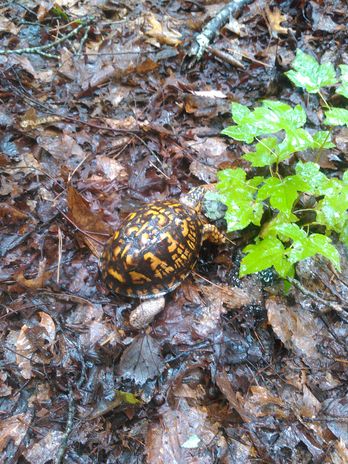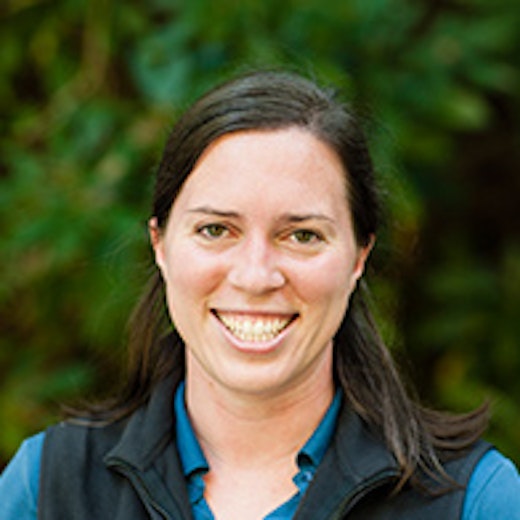
A surprising technique for teaching environmental education
I read an article a while back that focused on a major challenge of outdoor education. The writer spoke about a recent experience where he had taken his children to a local park for a naturalist-led hike. As the children meandered through the forest, they were drawn to flowers, sticks, and other plants along the way. Each time the children sought to examine the natural objects further, the naturalist exclaimed “Nature is very fragile! When you walk off trail you crush all kinds of little creatures you can’t see.” The writer goes on to describe how environmental education has the tendency to take on a museum mentality. Research indicates that “Look. Don’t touch.” is a surprisingly dangerous refrain for children to hear when they are out in the woods, especially if you are striving to inspire a connection to the land and to instill conservation and environmental values.
 In 2012, I came to GRP to work as one of the Mentor Naturalists, leading hikes each morning on our 3,400 acres of private, wildlife preserve. Prior to coming to GRP, I worked in a program that often leaned towards the museum mentality due to the sheer number of participants we had in a year on a relatively small piece of property. During training at GRP, I felt my heart swell up in my throat when we flipped over a piece of wood and discovered a ring neck snake. The senior mentor quickly scooped up the snake and displayed it for each of us to pet and examine further. Later, he encouraged us to bushwhack in a section and travel off trail. My Leave No Trace internal alarms were going bonkers and I almost couldn’t bring myself to step off the trail. It was against everything I had learned! Next, we harvested several wild edibles and snacked on live plants. Then, we traveled to the river and set up a kicknet in the river and our fearless leader rolled over rocks and brushed the underside clean before replacing them. The kicknet was full of squirmy macroinvertebrates who had been taken from their homes. We were doing all the things I had cautioned my students against previously. How could I possible continue to teach the idea of “Take only pictures, leave on footprints” when we were so clearly disturbing elements of this ecosystem and interrupting the days of all of these animals?
In 2012, I came to GRP to work as one of the Mentor Naturalists, leading hikes each morning on our 3,400 acres of private, wildlife preserve. Prior to coming to GRP, I worked in a program that often leaned towards the museum mentality due to the sheer number of participants we had in a year on a relatively small piece of property. During training at GRP, I felt my heart swell up in my throat when we flipped over a piece of wood and discovered a ring neck snake. The senior mentor quickly scooped up the snake and displayed it for each of us to pet and examine further. Later, he encouraged us to bushwhack in a section and travel off trail. My Leave No Trace internal alarms were going bonkers and I almost couldn’t bring myself to step off the trail. It was against everything I had learned! Next, we harvested several wild edibles and snacked on live plants. Then, we traveled to the river and set up a kicknet in the river and our fearless leader rolled over rocks and brushed the underside clean before replacing them. The kicknet was full of squirmy macroinvertebrates who had been taken from their homes. We were doing all the things I had cautioned my students against previously. How could I possible continue to teach the idea of “Take only pictures, leave on footprints” when we were so clearly disturbing elements of this ecosystem and interrupting the days of all of these animals?
Looking back and at the time, I found this experience invigorating, captivating, and most of all, memorable. I have been on hundreds of hikes in my lifetime and the ones on the Preserve always seem to stand out because there is the freedom and permission to explore, dissect, and destroy.
That’s right, I said destroy. Destruction is one of the best teaching tools. It was true in fourth grade when we dissected household electronics using hand tools just to see the inside of a walkman or a TV. It was true in high school when we dissected a frog. It is still true when I take apart a machine or electronic to figure out why it isn’t working. Without destruction, it is virtually impossible to understand how the world works and furthermore, to create and to build. By learning how to take things apart and understanding how pieces work together to create an object, then we are faced with the challenge of how to put the whole thing back together again and make it functional again. It’s a brilliant exercise in curiosity, problem solving, and observation.
 One of my favorite opportunities for destruction at GRP is when campers visit the farm and are taught about good bugs (good for the farm and surrounding ecosystems) and bad bugs (damaging to the farm, sometimes non-native invasives). One day, as campers and staff searched the plants for bad bugs, I found myself hesitant at first to squish a little black bug that I had caught. It had beautiful red and orange stripes on its back. The quickest and simplest way to destroy the bad bug was to simply rip off its heads and the bug’s destruction would help the plants on the farm stay healthy to grow delicious produce that we would snack on later in the summer. I shyly stared at the squirming legs of the bug and then popped its head off. A yellow liquid gooed from the inside and the wings fluttered one last time before lying flat. It was an anatomy lesson, an ethics lesson, and an ecosystem lesson all rolled into one small headless bug whose insides now stained my skin. “Gross.” I thought. “And so cool,” I thought as I heard a camper squeal with excitement at the brightly colored beetle she had caught. It was a good bug—one to be saved from this fate of beheading. She carried around “George” until it was time to leave the farm and then carefully placed him under a rock near where she found the critter originally.
One of my favorite opportunities for destruction at GRP is when campers visit the farm and are taught about good bugs (good for the farm and surrounding ecosystems) and bad bugs (damaging to the farm, sometimes non-native invasives). One day, as campers and staff searched the plants for bad bugs, I found myself hesitant at first to squish a little black bug that I had caught. It had beautiful red and orange stripes on its back. The quickest and simplest way to destroy the bad bug was to simply rip off its heads and the bug’s destruction would help the plants on the farm stay healthy to grow delicious produce that we would snack on later in the summer. I shyly stared at the squirming legs of the bug and then popped its head off. A yellow liquid gooed from the inside and the wings fluttered one last time before lying flat. It was an anatomy lesson, an ethics lesson, and an ecosystem lesson all rolled into one small headless bug whose insides now stained my skin. “Gross.” I thought. “And so cool,” I thought as I heard a camper squeal with excitement at the brightly colored beetle she had caught. It was a good bug—one to be saved from this fate of beheading. She carried around “George” until it was time to leave the farm and then carefully placed him under a rock near where she found the critter originally.
 Don’t pick this wildflower! Photo courtesy of http://www.nhdfl.org/
At GRP, I find there is a balance that we carefully navigate. Prior to departing for Campout, campers learn about outdoor ethics and how to follow Leave No Trace ethics. On hikes, a discussion often ensues about the option of leaving the cool stuff that we find behind so, out of fairness, other groups get to seem those same cool things. And yet, how many of your campers have come home with that special rock, stick, feather, arrowhead, or leaf that felt important and valuable in the very moment when it was discovered on a hike? How many have spoken of eating a leaf of sourwood or crunching on the berries of Salomon Seal?
Don’t pick this wildflower! Photo courtesy of http://www.nhdfl.org/
At GRP, I find there is a balance that we carefully navigate. Prior to departing for Campout, campers learn about outdoor ethics and how to follow Leave No Trace ethics. On hikes, a discussion often ensues about the option of leaving the cool stuff that we find behind so, out of fairness, other groups get to seem those same cool things. And yet, how many of your campers have come home with that special rock, stick, feather, arrowhead, or leaf that felt important and valuable in the very moment when it was discovered on a hike? How many have spoken of eating a leaf of sourwood or crunching on the berries of Salomon Seal?
We are fortunate to host no more than 520 campers per summer and another 500 participants through our school programs and then Green River Preserve lies dormant from November to April. The land can recover from the footsteps off trail and the disruption of habitats. The animals and critters have time to experience their natural life cycles without the watchful eyes of the campers and staff. Our instructors are knowledgeable in the really sensitive, rare, or dangerous habitats and can use our encounters with these areas to instill a sense of caution and appreciation for the lone green salamander nesting site, the one pink lady slipper next to the trail, or the den of the copperhead on the Balds. It is this balance of having opportunities to touch, taste, small, feel, and destroy that instills in our participants the necessity to protect, maintain, and conserve.
As the forest reawakens this spring, I challenge you to find a natural place where it is appropriate for your child to dissect, destroy, and investigate. I challenge you to allow your children to get dirt under their fingernails, fill their shoes with water, and pick flowers. I challenge you to leave the museum mentality behind and get a little mud in between your toes.
